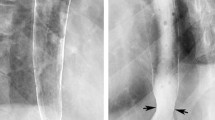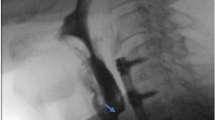Abstract
Three hundred multiphasic examinations of the lower esophagus and esophagogastric region were assessed to determine the individual sensitivities of the full-column, mucosal relief, and double contrast techniques in the detection of common structural abnormalities, such as hiatal hernia, lower esophageal rings, and peptic strictures. In 159 patients, there were 211 structural abnormalities including 153 hiatal hernias, 35 mucosal rings, 20 peptic strictures, and 3 esophageal diverticula. The overall sensitivity of the full-column technique in detecting these abnormalities was 100% compared to 52% and 34% for the mucosal relief and double-contrast techniques, respectively. We conclude that the prone full-column technique must be incorporated into any examination of the esophagogastric region if these common abnormalities are to be demonstrated reliably.
Similar content being viewed by others
References
Gelfand DW, Ott DJ: Anatomy and technique in evaluating the esophagus.Semin Roentgenol 16:168–182, 1981
Maglinte DDT, Schultheis TE, Krol KL, Caudill LD, Chernish SM, McCune WM: Survey of the esophagus during the upper gastrointestinal examination in 500 patients.Radiology 147:65–70, 1983
Ott DJ, Dodds WJ, Wu WC, Gelfand DW, Hogan WJ, Stewart ET: Current status of radiology in evaluating for gastroesophageal reflux disease.J Clin Gastroenterol 4:365–375, 1982
Ott DJ, Gelfand DW, Lane TG, Wu WC: Radiologic detection and spectrum of appearances of peptic esophageal strictures.J Clin Gastroenterol 4:11–15, 1982
Wu WC: Esophageal rings and webs. In Castell DO, Johnson LF (eds):Esophageal Function in Health and Disease. New York: Elsevier Biomedical, 1983, pp 73–83
Overstreet PA: Is the P2 endoscope properly used?Gastrointest Endosc 26:24, 1980
Dodds WJ: Rings, webs, and strictures. In Margulis AR, Burhenne HJ (eds);Alimentary Tract Radiology, vol 1, third ed. St. Louis: C.V. Mosby, 1983, pp 574–582
Kaufmann HJ: Esophageal roentgenographic “abnormalities” in patients without esophageal symptoms.J Clin Gastroenterol 1:313–316, 1979
Ott DJ, Gelfand DW, Wu WC, Castell DO: Esophagogastric region and its rings.AJR 142:281–287, 1984
Schatzki R, Gary JE: Dysphagia due to a diaphragm-like localized narrowing in the lower esophagus (“lower esophageal ring”).AJR 70:911–922, 1953
Wolf BS, Brahams SA, Khilnani MT: The incidence of hiatus hernia in routine barium meal examination.Mt Sinai J Med 26:598–600, 1959
Stein GN, Finkelstein A: Hiatal hernia. Roentgen incidence and diagnosis.Am J Dig Dis 5:77–87, 1960
Donner MW, Margulies SI: Radiographic examination. In Skinner DB, Belsey RHR, Hendrix TR, Zuidema GD (eds):Gastroesophageal Reflux and Hiatal Hernia. Boston: Little, Brown, 1972, pp 59–85
Balfe DM, Koehler RE, Weyman PJ, Baron RL, Reinus WR: Routine air-contrast esophagography during upper gastrointestinal examinations.Radiology 139:739–741, 1981
Cassel DM, Anderson MF, Zboralske FF: Double-contrast esophagrams. The prone technique.Radiology 139:737–739, 1981
Johnson LF: Hiatal hernia influence on gastroesophageal reflux disease. In Castell DO, Johnson LF (eds):Esophageal Function in Health and Disease. New York: Elsevier Biomedical, 1983, pp 47–51
Behar J: Gastroesophageal reflux disease and its complications with a critical analysis of treatment. In Cohen S, Soloway RD (eds):Diseases of the Esophagus. New York: Churchill Livingstone, 1982, pp 195–213
Wright RA, Hurwitz AL: Relationship of hiatal hernia to endoscopically proved reflux esophagitis.Dig Dis Sci 24:311–313, 1979
Schatzki R: The lower esophageal ring: long term follow-up of symptomatic and asymptomatic rings.AJR 90:805–810, 1963
Creteur V, Thoeni RF, Federle MP, Cello JP, Moss AA, Ominsky SH, Goldberg HI, Axel L: The role of single and double-contrast radiography in the diagnosis of reflux esophagitis.Radiology 147:71–75, 1983
Author information
Authors and Affiliations
Rights and permissions
About this article
Cite this article
Chen, Y.M., Ott, D.J., Gelfand, D.W. et al. Multiphasic examination of the esophagogastric region for strictures, rings, and hiatal hernia: Evaluation of the individual techniques. Gastrointest Radiol 10, 311–316 (1985). https://doi.org/10.1007/BF01893119
Received:
Accepted:
Issue Date:
DOI: https://doi.org/10.1007/BF01893119




